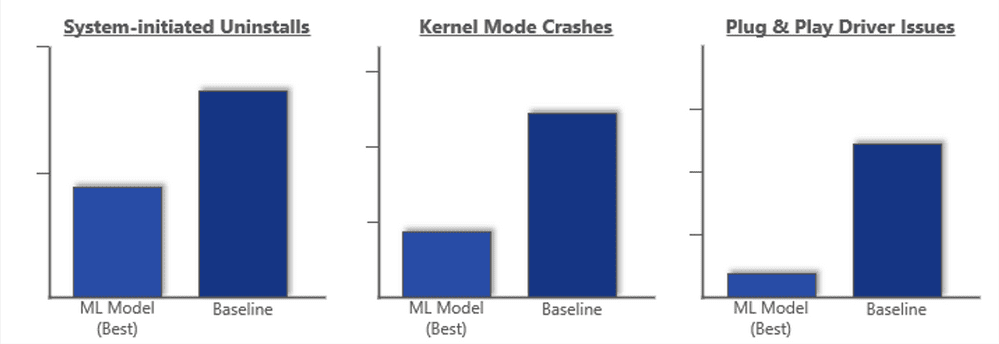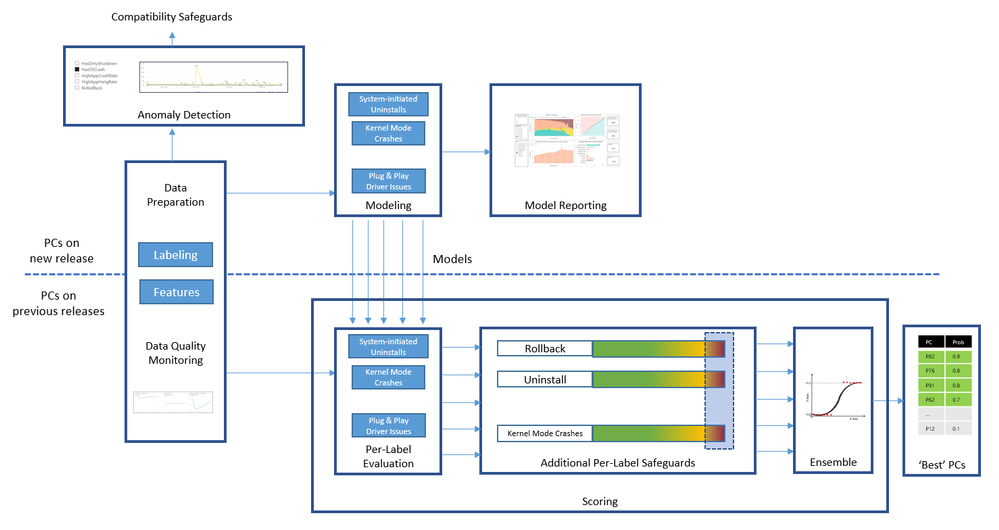Microsoft's large-scale use of machine learning (ML) in Windows Update in April 2018 for the first time, ML by six core areas to monitor the health of the PC (for example, overall reliability), to determine whether the update process function smoothly. In the update push May 2019 release, which is Microsoft's use of ML third iteration, the field can assess increased to 35, Microsoft plans to further expand the coverage in future updates.
Microsoft said the use of ML to deploy the updates have a better update experience, such as the following figure, the number of unloading updated by ML initiated system less than half the number of cores collapse reduced by half, and the number of driver issues after the update is reduced five times.

Microsoft is how to design and build support for Windows 10 update of machine learning models
Recently, Microsoft released Bowen introduced this technical information. Microsoft uses a dynamic training through the model, which through training in the latest update of the PC, there is the ability to distinguish between good and bad update experience. Below is a detailed diagram of machine learning, showing the overall framework of machine learning algorithms.

Each updated version of Windows 10 are first push to early adopters (such as Windows update internal staff and seek people). With these experiences were, Microsoft developers can diagnostic data (such as the kernel mode crashes, closes unexpectedly and driver problems) to monitor their updated experience.
Machine Learning provides two key features in which:
- It identified a number of issues are security risks, which can take timely measures to protect the PC has not been updated for Windows developers can promptly investigate and resolve these issues
- It predicted and found that PC can be updated smoothly, providing updates
Such a process is repeated every day, continue to get the model to learn from the recent update of the PC. Then over time and continue to solve problems, compared to those in the past have updated the PC on the defect, but better to learn now will re-experience them updated.
Microsoft uses Azure Databricks build ML model, to assess those ready to upgrade the PC (preparing the data, create a single model, and calculate the score):

Microsoft said the introduction of ML-driven process, a key factor is the ability to have early detection of compatibility issues, allowing them to establish conservation measures to protect the other PC does not perform this update. And in the past, it is difficult compatibility issues through laboratory testing, feedback and other channels detected. Although these methods are still in use, but Microsoft's complex ecosystem, the ML applied to the diagnostic data of the PC, Microsoft will be able to more quickly identify any compatibility updates related characteristics such as hardware, drivers, application etc.
To find compatibility issues, they use anomaly detection to detect certain characteristics or patterns at what time due to the failure rate will be higher than the overall expectations. By using Azure Databricks, you can quickly extended to millions of PC, and to establish protective measures to prevent the PC is updated potential problems related to interference. The following figure shows a certain function or mode of failure was 82%, while about 3% failure rate reference. To determine the need to protect the position to prevent other PC with similar problems:

Microsoft said the current machine learning program is not perfect, the next will be the further development of ML, ML is to ensure comprehensive, more automated and flexible, able in a few seconds rather than within a few hours to solve the problem.
Reference: https://www.ithome.com/0/447/862.htm